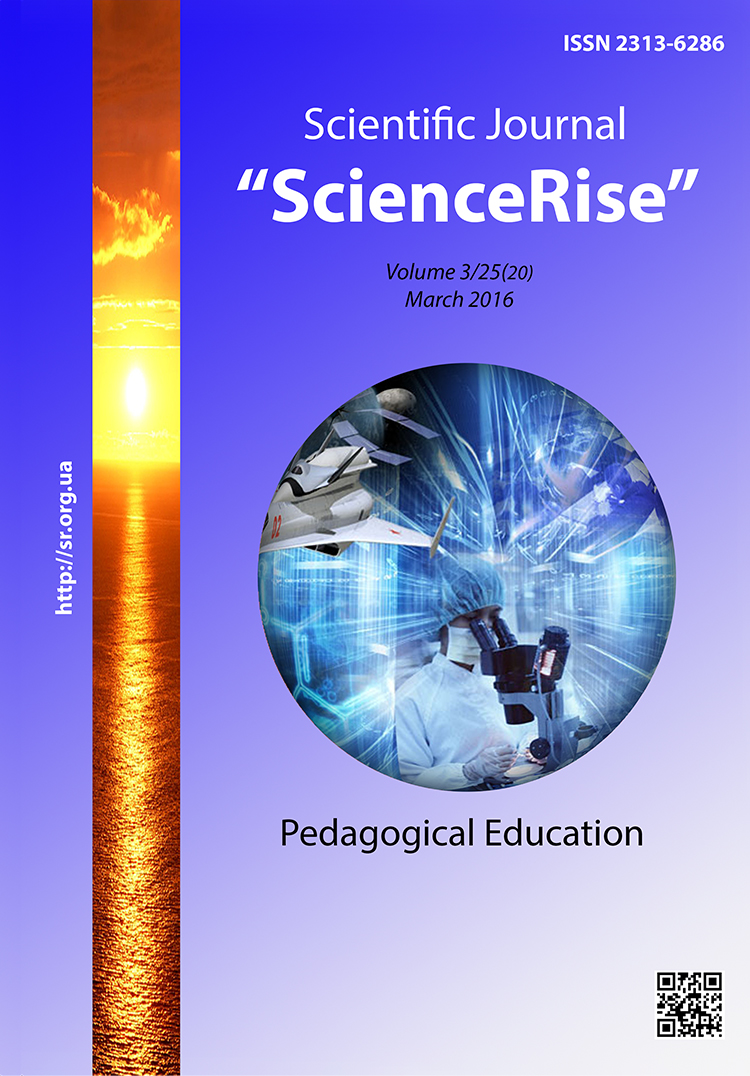The senior pupils’ understanding of the essence of manipulative strategies in communicative sphere
DOI:
https://doi.org/10.15587/2313-8416.2016.64567Keywords:
manipulative strategy, influence, communicative sphere, senior pupil, educational process, teacherAbstract
The article is dedicated to the problem of an adequate understanding of the manipulative strategy in educational process of the modern school by the high school aged pupils. The topicality of the problem is connected with inadequate spread of manipulative interaction in all life spheres. The deficiency of the skill of expedient use of manipulation in pedagogical process as well as fixing manipulation as the main way of relation construction are the unfavorable variants of human development. There were characterized the main influence strategies in communication. There were cited the results of techniques and creative tasks that allow to reveal the understanding of essence of manipulative strategy and to study its functioning in the senior pupils’ communicative plane. The special authors’ attention was concentrated on determination of pedagogical conditions of mastering the experience of manipulative communication by the high school aged pupils. In the process of research there were determined the certain threatening moments: the significant part of senior pupils does not understand their own manipulative actions, but see it in surrounding people and is ready to aggressive response. The ability to use the ways of flexible, adaptive countermanipulation that allow retain communicative connections between pupils and teachers is not sufficiently developed in the pupils of high school age
References
Rogov, E. I. (2008). Uchitel kak object psihologicheskogo issledovanijya [The teacher as an object of psychological research]. Moscow: Prosveshhenie, 410.
Kozachek, O. (2009). Psihologicheskaya manipulyatsiya: za i protiv [Psychological manipulation: pros and cons]. Public education, 2, 265–272.
Volkova, N. P. (2006). Pedagogika [Pedagogy]. Kyiv: Publishing center «Academy», 576.
Dotsenko, E. L. (2006). Psihologiya manipylyatsiji: fenomeni, mehanizmi I zatschita [Psychology manipulation: phenomena and mechanisms of protection]. Sankt-Peterburg: Rech', 304.
Pankratov, W. N. (2005). Manipulyatsiji v obtcheniji I ih neitralizatsiya [Manipulations in communication and their neutralization]. Moscow: «Institut psihoterapii», 209.
Rumchina, L. I. (2007). Vliyanije manipulyativnih ustanovok lichnosti na vzaimoponimanije [Effect of manipulative personality settings for mutual understanding]. World of Psychology, 3, 88–93.
Skazenik, E. N. (2005). Praktikum po delovomy obscheniyu [Practical workon business intercourse]. Taganrog: Publishing ТRТY, 350.
Shejinov, W. P. (2007). Skritoje upravlenije tshelovekom [Hidden People Management]. Minsk: Harvest, 848.
Shostorm, E. (2005). Tchelovek-manipulyator. Vnutrenneje putechestvije ot manipuliyatsiji k aktualizatsiji [Man-manipulator. The inner journey of manipulation to actualization]. Kyiv: PSYLIB, 82.
Filatov, A. V., Filatova, V. N. (2004). Osnovi razpoznavaniya I protivodijstviya manipulyatsiji soznanijem [Basics of recognizing and combating the manipulation of consciousness]. Мoscow: Sente, 200.
Downloads
Published
Issue
Section
License
Copyright (c) 2016 Інна Іванівна Киричок, Валентина Григорівна Кучерявець, Степан Миколайович Возняк

This work is licensed under a Creative Commons Attribution 4.0 International License.
Our journal abides by the Creative Commons CC BY copyright rights and permissions for open access journals.
Authors, who are published in this journal, agree to the following conditions:
1. The authors reserve the right to authorship of the work and pass the first publication right of this work to the journal under the terms of a Creative Commons CC BY, which allows others to freely distribute the published research with the obligatory reference to the authors of the original work and the first publication of the work in this journal.
2. The authors have the right to conclude separate supplement agreements that relate to non-exclusive work distribution in the form in which it has been published by the journal (for example, to upload the work to the online storage of the journal or publish it as part of a monograph), provided that the reference to the first publication of the work in this journal is included.

